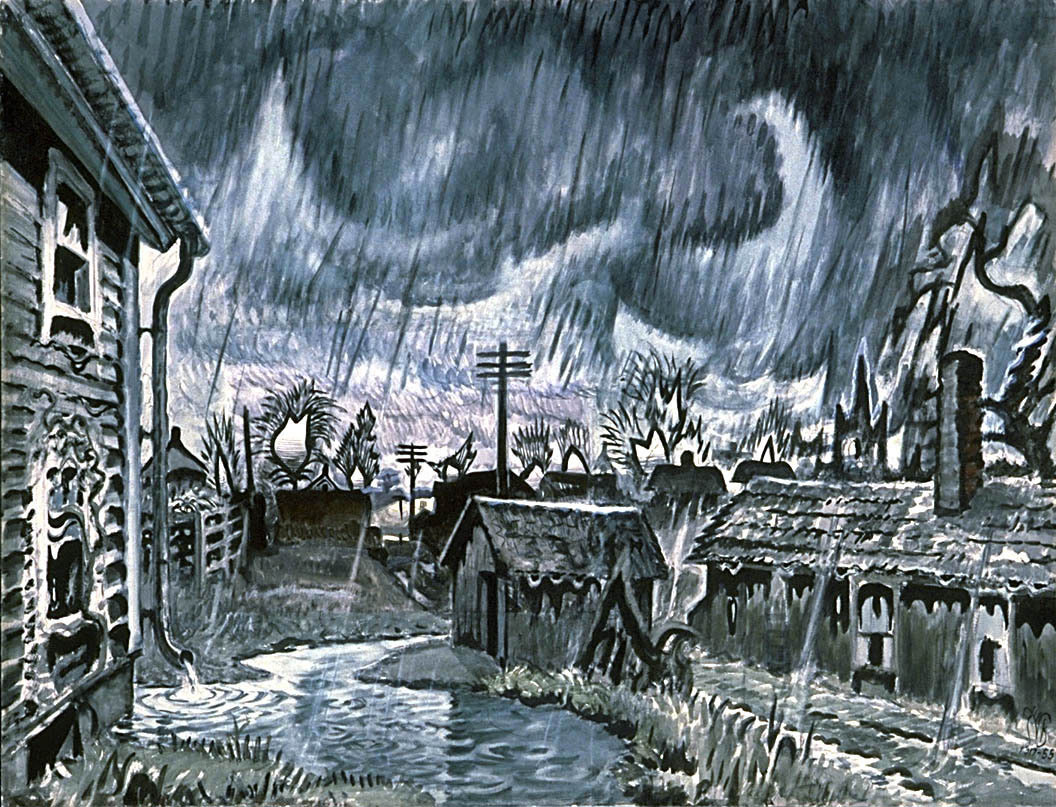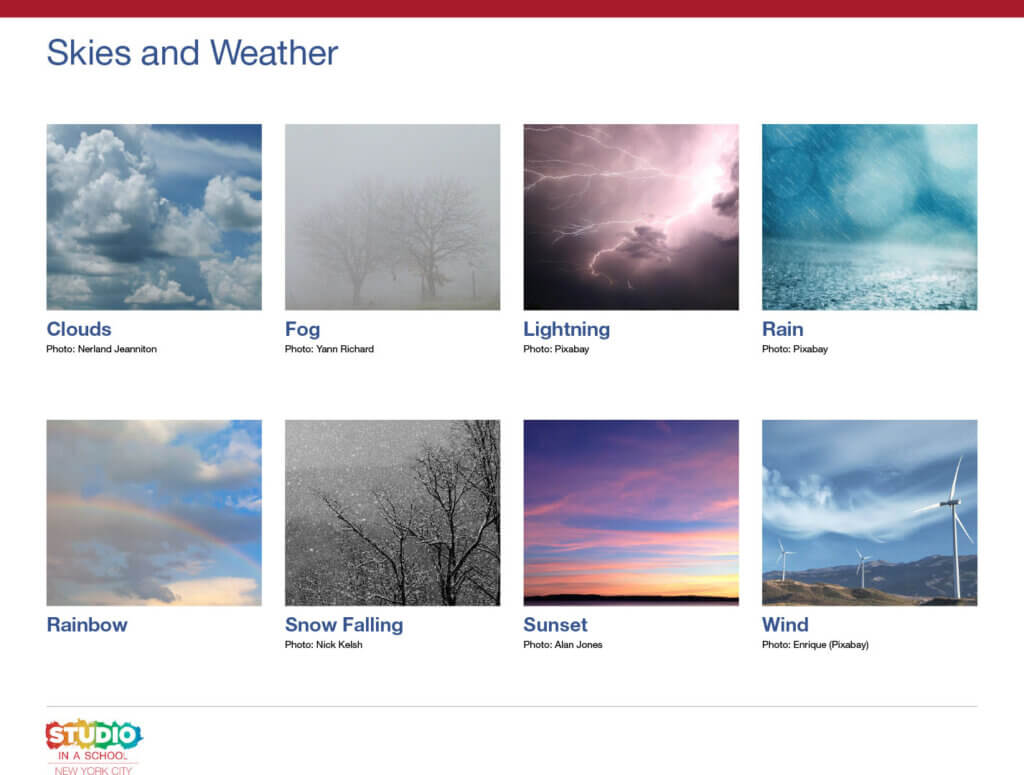Overview
In this lesson, students will use various lines and shades to describe how a type of weather looks, feels, sounds, and moves.
Materials and Tools
- Drawing paper (one sheet)
- Drawing pencils
- Line exploration and weather sketch exercises from previous lesson
Objectives
Students will understand that:
- There are many different types of lines that can be found all around us.
- Artists use different types of lines to describe how something looks, feels, sounds, and moves.
- Artists can create dark, medium, and light shades by changing the pressure put on their pencil.
- Using different shades can affect the mood of a drawing.
Students will be able to:
- Draw a variety of lines.
- Create different types of shades with their pencil.
- Use different kinds of lines and shades to describe a type of weather.
Activities
Engagement
Reflect on the previous lesson and review lines and shades used to describe different types of weather.
Examples of types of lines:
- Straight
- Curvy
- Dotted
- Zigzag
- Diagonal
- Bumpy
- Swirly
Show:
Look at drawings by Vincent van Gogh and/or Charles Burchfield for inspiration.
Demonstrate:
Start a drawing of a landscape with weather, asking students for suggestions or ideas.
Work Time
Using a new sheet of paper, students will use lines and shades to draw a landscape showing a type of weather. Students can choose a type of weather from their exploration exercise in the previous lesson or choose a type of weather from their experience (using memory).
Examples of types of weather
- A storm with thunder, lightning, and hard rain
- A very foggy morning
- A blizzard with snow and wind
- A very, very hot and humid day
- Light drizzle with a breeze
- A storm with hail and ice
- A sandstorm
- A tornado
- A dark, cloudy, windy day
Motivation Questions
- Can you think of a time when weather affected your day significantly?
- As you draw, imagine standing in your landscape. What would it feel and sound like?
- Is the weather causing anything to move in your picture? How will you show this?
- What will you include in your scene (examples: trees, flowers, clouds, bushes, water, houses, roads, people, mountains, buildings, people)?
- What will be your point of view? Will it be seen from far away or close up?
- What type of lines will you use to describe the weather (examples: zigzag, spiral, horizontal, vertical, thick, thin, straight, curved, curly, wavy, dotted, short, long, wispy, castle line, crisscross, dashed)?
- Will you use shading?
- Will your lines be light, dark, or medium?
Reflection
Prompts for Discussion
- How do the lines in your drawing describe the way the weather feels?
- How do the lines in your drawing describe the way the weather sounds?
- How did you show something moving in your weather drawing?
- How does the use of shading affect the overall mood of your drawing?
Additional Discussion Questions
- Can you find a line that you drew that looks like it would feel soft? What makes you say that?
- Can you find a line that you drew that looks like it would feel sharp? What do you see that makes you say that?
Close-Looking Activity

The artist Charles Burchfield drew and painted landscapes to express his dreams and childhood memories. In his artwork Night of the Equinox, he captured a memory of a rainstorm he saw from his backyard. He remembers the clouds being dark and the trees moving so fast they looked like they were dancing in the air.
- What do you notice?
- How did the artist use different kinds of lines to show this weather?
- How did the artist use different shades to show the weather?
- What words would you choose to describe this scene? Why?
- If you were standing in this scene, how would it feel? What would it sound like? What do you see that makes you say that?
Speaking Prompt
Discuss a memory with a classmate or a family member about a time when the weather affected your day in a significant way. This could be a time when the weather was perfect for flying a kite or going to the beach, or maybe it snowed, and you were unable to leave your house.
Writing Activity
Write about a memory of a time when the weather affected your life in some way.
- For example: “I remember being in a theater watching a play with my father during a huge rainstorm. It was so loud because of thunder and the rain fell very hard and fast. All of a sudden, the lights went out in the theater. It was scary but I held on to my dad’s hand. When we got home a tree had fallen on our neighbor’s house. No one got hurt but they had to replace the roof. Luckily our house was fine, but the lights didn’t work for two days.”
Or
Write an imaginary story using your weather drawing as the setting. How will the weather affect the plot of your story?
- Use the book, The Snowy Day by Ezra Jack Keats, as an example.
Sketchbook Activity
Look at your weather drawing from the previous lesson. Weather is always changing. Make a drawing of what the scene would look like right before your weather drawing. You can also do a sketch of what it would look like right after your weather drawing. How is the weather different right before or right after? What lines will you choose to show the change in the weather? Will your scene be lighter or darker?
Vocabulary
Types of lines (zigzag, spiral, bumpy, horizontal, vertical, thick, thin, straight, curved, curly, wavy, jagged, dotted, dash, short, long, wispy, castle, crisscross), shade, pressure, landscape
Resources


Adaptations
ADAPTATIONS FOR STUDENTS WITH DISABILITIES
- Think about the sounds a line might make or that one might hear in an artwork.
- Use hand and body movements to make lines.
- Use sounds to describe lines.
- Use an iPad or Google Classroom to draw lines and shapes.
- Use the “Think, Pair, Share” strategy to help students understand, verbalize ideas, and share their process.
ADAPTATIONS FOR MULTILINGUAL LEARNERS
- Multi-modality learning
- Total Physical Response (TPR)
- Provide visual examples
- Use demonstrations
- Use repetition
- Use equity sticks when calling on students
- Utilize visuals and realia to support words and concepts
Extensions
- Keeping a writing and drawing weather journal
- Exploring Line, Exploring Weather lesson using watercolor, ink, or tempera paint
- Landscape or cityscape painting using watercolor, ink, or tempera paint
- Paintings or drawings of different habitats using pencil, watercolor, ink, or tempera paint
- Drawing to music (sound-movement connection)
- Abstract collage using scissors to cut different lines that become shapes
Credits
Written By:
Belinda Blum, Artist Instructor
Lesson Development:
Julie Applebaum, Senior Director
Copyright © 2023 Studio in a School NYC LLC
